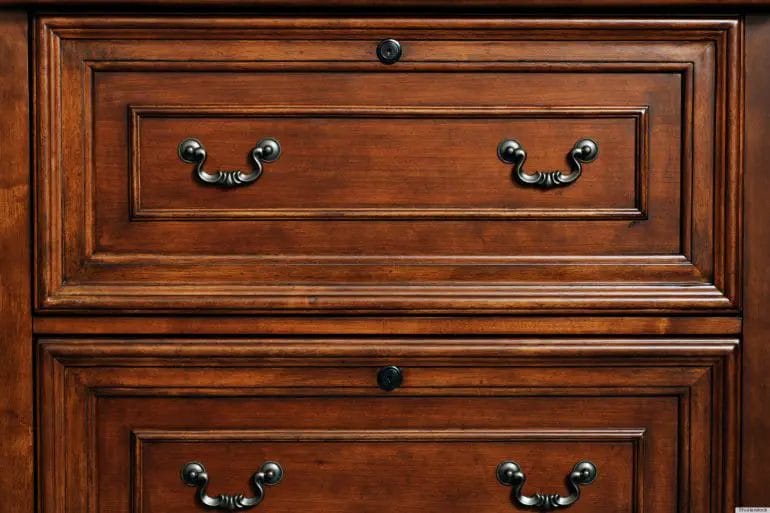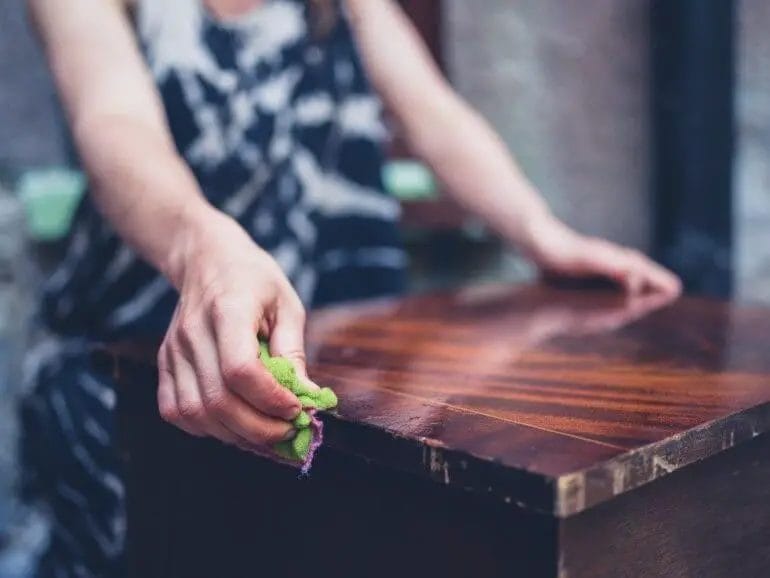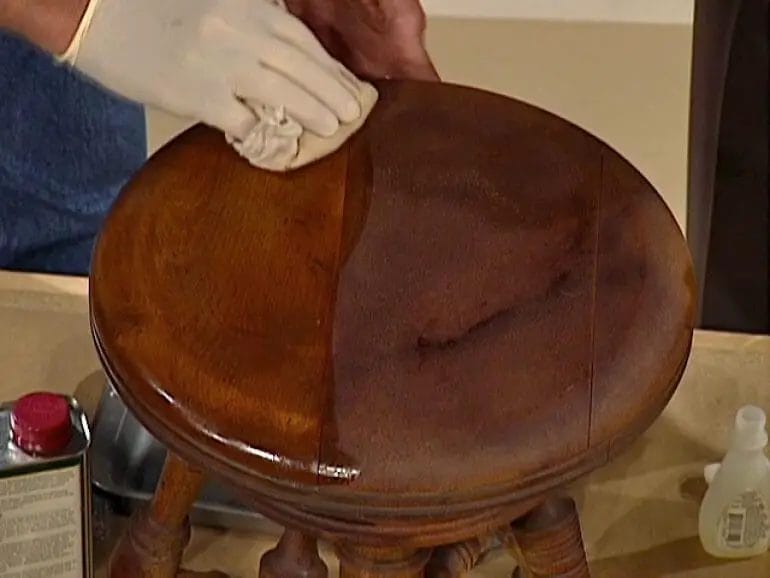Cleaning antique wood furniture requires special care and attention to preserve its beauty and value. Regular dusting and gentle cleaning techniques can help prolong the lifespan of these timeless pieces.
Start by dusting the furniture with a soft cloth or brush to remove any loose dirt or debris. Avoid using harsh chemicals or abrasive materials that can damage the delicate wood finish.

If there are stains or sticky residue, use a mild solution of warm water and a gentle soap to gently clean the surface. Test the solution on a small, inconspicuous area first to ensure it doesn’t cause any discoloration or damage.
For stubborn stains, you can try using a mixture of equal parts vinegar and water or a specialized wood cleaner recommended for antique furniture. Apply the solution sparingly and gently rub the stain in a circular motion with a soft cloth.
Remember to always dry the furniture thoroughly after cleaning to prevent any moisture from seeping into the wood. Finish off with a coat of high-quality furniture polish or wax to restore its natural shine and protect the wood from further damage.

Gentle Cleaning Techniques for Preserving Antique Wood Furniture
Antique wood furniture adds a touch of elegance and charm to any living space. The patina and character of aged wood are unmatched, making these pieces highly prized by collectors and enthusiasts. However, caring for antique wood furniture requires special attention to preserve its beauty and value. In this section, we will explore gentle cleaning techniques that will help you maintain the integrity of your antique wood furniture.
1. Dusting with Soft Brushes
The first step in cleaning antique wood furniture is to remove dust and debris gently. Dust particles can accumulate over time and may lead to surface scratches if not removed properly. To avoid causing any damage, use a soft-bristled brush or a microfiber cloth to gently dust the surface of the furniture. Be sure to reach into crevices and ornate details, as dust tends to accumulate in these areas.
2. Using Mild Wood Cleaners
When it comes to cleaning antique wood furniture, it is crucial to choose the right cleaning products. Harsh chemicals or abrasive cleaners can strip away the delicate finish or cause discoloration. Instead, opt for mild wood cleaners that are specifically formulated for antique wood furniture. These cleaners are gentle yet effective in removing dirt and grime without compromising the integrity of the wood.
3. Spot Cleaning Stains
If you notice a stain on your antique wood furniture, it is essential to address it immediately. Leaving stains untreated can lead to permanent damage to the wood. To spot clean stains, create a mixture of mild soap and warm water. Dip a clean cloth into the solution and gently blot the stain, avoiding any rubbing or scrubbing motions. Afterward, rinse the area with a damp cloth and pat dry.
4. Polishing with Beeswax or Paste Wax
Polishing antique wood furniture not only enhances its natural beauty but also adds a protective layer to the surface. Beeswax or paste wax is ideal for this purpose, as it nourishes the wood and helps retain its luster. Apply a small amount of wax onto a clean cloth and rub it onto the furniture using circular motions. Allow the wax to sit for a few minutes before buffing it off with a soft cloth.
5. Avoiding Excessive Moisture
One of the most important aspects of preserving antique wood furniture is to avoid excessive moisture. Water can seep into the wood and cause swelling, warping, or even mold growth. Always use a damp cloth for cleaning and immediately wipe away any excess moisture. Additionally, avoid placing antique wood furniture near sources of moisture, such as windows or bathrooms.
6. Protecting from Sunlight and Heat
Direct sunlight and high temperatures can cause fading, drying, or cracking in antique wood furniture. It is crucial to protect your pieces from these elements. Avoid placing them in areas where they will be exposed to prolonged sunlight, and use window treatments or UV-protective films to block out harmful rays. Additionally, maintain a stable room temperature to prevent extreme fluctuations that can be detrimental to the wood.
7. Consulting a Professional
If you are unsure about the proper cleaning or restoration methods for your antique wood furniture, it is always best to consult a professional. They have the expertise and experience to handle delicate pieces and can provide guidance on the best techniques and products to use. Professional restoration can also help revitalize the beauty of your antique wood furniture and extend its lifespan.
Summary
Preserving antique wood furniture requires a delicate touch and the use of gentle cleaning techniques. Dusting with soft brushes, using mild wood cleaners, spot cleaning stains, and polishing with beeswax or paste wax are effective methods for maintaining the integrity and beauty of these pieces. It is essential to avoid excessive moisture, protect from sunlight and heat, and consult a professional for expert advice. By following these tips, you can ensure that your antique wood furniture remains a cherished treasure for generations to come.

Natural Remedies for Restoring the Shine to Antique Wood Furniture
Antique wood furniture brings a touch of elegance and history to any space. However, over time, the shine on these treasured pieces can fade due to exposure to sunlight, dust, and regular wear and tear. While there are commercial products available for restoring the shine, many people prefer to use natural remedies to avoid harsh chemicals.
Lemon and Olive Oil
One of the most effective natural remedies for restoring the shine to antique wood furniture is a mixture of lemon and olive oil. Lemon acts as a natural cleanser and helps remove dirt and grime, while olive oil nourishes and moisturizes the wood.
To create this remedy, mix equal parts lemon juice and olive oil in a bowl. Dip a soft cloth into the mixture and gently rub it onto the wood in circular motions. Allow the mixture to sit on the surface for a few minutes before buffing it off with a clean cloth. The lemon will remove any stains or discoloration, while the olive oil will restore the shine.
Vinegar and Water
Vinegar is another natural ingredient that can be used to restore the shine to antique wood furniture. Its acidic properties help cut through grease and grime, leaving the wood looking clean and shiny.
To make a vinegar and water solution, mix equal parts distilled white vinegar and water in a spray bottle. Spray the solution onto a soft cloth and gently wipe down the surface of the furniture. Be sure to follow the wood grain to prevent any damage. Once cleaned, use a dry cloth to buff the wood and bring out its natural shine.
Tea Bags
Believe it or not, tea bags can also be used to restore the shine to antique wood furniture. The tannic acid found in tea helps remove dirt and adds a natural luster to the wood.
Start by steeping a few tea bags in boiling water until a strong tea is brewed. Allow the tea to cool down, then dip a soft cloth into the liquid. Wring out any excess tea and gently wipe the furniture, following the wood grain. The tannic acid will work its magic, leaving the wood looking revitalized and shiny.
Baking Soda and Water
Baking soda is a versatile household ingredient that can be used for various cleaning purposes, including restoring the shine to antique wood furniture.
To use baking soda, create a paste by mixing equal parts baking soda and water. Apply the paste to a soft cloth and gently rub it onto the wood in circular motions. The baking soda will help remove stains and bring back the shine. After scrubbing, wipe off the paste with a clean, damp cloth, and then buff the wood with a dry cloth to reveal the restored shine.
Using natural remedies to restore the shine to antique wood furniture is a safe and effective way to breathe new life into these cherished pieces. Whether using lemon and olive oil, vinegar and water, tea bags, or baking soda, these natural ingredients can help remove dirt, grime, and stains while bringing back the original luster and shine of the wood. Try out these remedies on your antique wood furniture and enjoy the beauty and elegance they can bring to your space.

Tips for Maintaining Antique Wood Furniture’s Original Finish
Antique wood furniture holds a charm and beauty that cannot be replicated by modern pieces. The natural patina and craftsmanship of these timeless treasures make them a valuable addition to any home. To preserve the original finish and keep your antique wood furniture looking its best, follow these essential tips:
1. Gentle Cleaning
Cleaning antique wood furniture requires a delicate touch. Avoid using harsh chemical cleaners or abrasive scrubbing tools that can damage the finish. Instead, start by removing any dust and dirt using a soft, lint-free cloth or a feather duster. Gently wipe the surface in the direction of the wood grain to avoid scratches.
2. Avoid Direct Sunlight
Sunlight can be detrimental to antique wood furniture, causing the finish to fade or darken over time. To protect your cherished pieces, avoid placing them in direct sunlight or near windows without proper UV protection. Use curtains or blinds to shield the furniture from harmful UV rays.
3. Use Protective Pads and Coasters
To prevent scratches, dents, and water rings, always use protective pads or coasters when placing items on your antique wood furniture. This is particularly important for objects that can release moisture or have rough bottoms. Investing in high-quality felt or rubber pads can help preserve the integrity of the furniture’s surface.
4. Regular Dusting and Polishing
Dust and polish your antique wood furniture regularly to maintain its luster. Choose a high-quality furniture polish that is specifically formulated for wood surfaces. Apply the polish sparingly using a soft cloth, following the manufacturer’s instructions. Avoid over-polishing, as this can lead to a buildup that dulls the finish.
5. Humidity Control
Wood is sensitive to changes in humidity, which can cause it to expand or contract, leading to cracks or warping. To prevent such damage, maintain a consistent humidity level in the room where your antique wood furniture is displayed. Use a humidifier or dehumidifier to regulate the moisture content, particularly in extreme weather conditions.
6. Handle with Care
When moving or handling antique wood furniture, always exercise caution to avoid accidental bumps or drops. Lift the furniture rather than dragging it to prevent scratches on the legs or surface. It is recommended to enlist the help of another person, especially for larger or heavier pieces.
7. Professional Restoration
If your antique wood furniture requires extensive repair or restoration, it is advisable to seek the assistance of a professional. They have the expertise and knowledge to handle delicate restoration processes without compromising the original finish. A professional restorer can also provide guidance on proper maintenance and care.
8. Climate-Controlled Storage
When not in use or during long-term storage, consider keeping your antique wood furniture in a climate-controlled environment. Extreme temperature fluctuations and high humidity levels in basements or attics can cause irreversible damage. Opt for a storage area that maintains stable temperature and humidity levels to preserve the wood’s condition.
9. Inspect Regularly
To catch any signs of damage or deterioration early on, inspect your antique wood furniture regularly. Look for cracks, loose joints, insect infestations, or any other issues that require attention. Promptly address any problems to prevent further damage and ensure the longevity of your cherished pieces.
10. Expert Appraisal
If you own valuable antique wood furniture, consider getting it appraised by a reputable expert. They can provide insights into the historical significance and value of your pieces. With their guidance, you can make informed decisions about preservation, restoration, or potential insurance coverage.
In summary, preserving the original finish of antique wood furniture requires gentle cleaning, protection from direct sunlight, the use of protective pads and coasters, regular dusting and polishing, humidity control, careful handling, professional restoration when necessary, climate-controlled storage, regular inspections, and expert appraisals for valuable pieces. By following these tips, you can maintain the beauty and integrity of your cherished antique wood furniture for generations to come.
Expert Advice on Preventing Damage to Antique Wood Furniture
Antique wood furniture can be a beautiful addition to any home, but it is also delicate and requires special care to prevent damage. Whether you have inherited a cherished heirloom or recently acquired a vintage piece, it is important to take the necessary steps to preserve its beauty and value. In this section, we will provide expert advice on how to prevent damage to your antique wood furniture.
1. Keep it Away from Direct Sunlight
One of the most significant threats to antique wood furniture is exposure to direct sunlight. Sunlight can cause the wood to fade and lose its luster over time. To prevent this damage, make sure to keep your furniture away from windows or use curtains or blinds to block the sun’s rays. You can also consider applying UV-blocking film to the windows to further protect your furniture.
2. Control the Humidity Levels
Extreme changes in humidity can cause wood to expand and contract, leading to cracks and warping. It is important to maintain a stable humidity level in the room where your antique furniture is placed. Aim for a humidity range of 40-45% to prevent any moisture-related damage. Use a humidifier or dehumidifier to regulate humidity levels if necessary.
3. Avoid Excessive Heat and Cold
Extreme temperatures can also damage antique wood furniture. Avoid placing your furniture near heat sources such as radiators or fireplaces, as this can dry out the wood and cause it to crack. Similarly, avoid exposing your furniture to freezing temperatures, as this can also lead to damage. Keep your furniture in a climate-controlled environment to maintain its integrity.
4. Clean Regularly and Gently
Cleaning your antique wood furniture regularly is essential to prevent dirt and grime buildup, which can degrade the finish over time. Use a soft, lint-free cloth to dust your furniture regularly. Avoid using harsh chemicals or abrasive cleaners, as these can damage the wood surface. If necessary, use a mild soap and water solution, but make sure to dry the surface thoroughly afterward.
5. Handle with Care
When moving or handling antique wood furniture, it is crucial to do so with care. Avoid dragging the furniture across the floor, as this can scratch or chip the wood. Lift the furniture from the base or support it from underneath to prevent strain on the joints. When placing objects on the furniture, use coasters or protective pads to prevent scratches and dents.
6. Maintain the Finish
The finish on antique wood furniture is meant to protect the wood and enhance its appearance. To maintain the finish, avoid placing hot objects directly on the surface, as this can leave heat marks. Use felt pads or tablecloths under objects to provide a protective barrier. If the finish becomes worn or damaged, consult a professional restorer to help restore its original beauty.
By following these expert tips, you can help prevent damage to your antique wood furniture and ensure its longevity. Remember to always be gentle and cautious when handling and cleaning your furniture, and create a suitable environment to protect it from the elements. With proper care and maintenance, your antique wood furniture will continue to be a cherished piece for generations to come.
FAQs
How do I clean antique wood furniture?
To clean antique wood furniture, start by dusting it with a soft cloth or brush to remove any loose dirt or debris. Then, mix a gentle cleanser with warm water and use a soft cloth to wipe down the surface of the furniture. Avoid using harsh chemicals or abrasive cleaners, as they can damage the wood. Finally, dry the furniture thoroughly with a clean cloth.
Conclusion
In conclusion, cleaning antique wood furniture requires careful attention and the use of appropriate techniques. By following the right steps, you can restore the beauty and longevity of these precious pieces.
First, start by dusting the furniture regularly to avoid accumulation of dirt and debris. Then, deep clean the wood using a mixture of mild soap and warm water, being careful not to soak the wood. For stubborn stains, try using a paste made of baking soda and water for gentle scrubbing.
Remember to always test any new cleaning method or product on a small, inconspicuous area first. Additionally, use a soft cloth or sponge to avoid scratching the delicate wood surface. Lastly, protect the cleaned furniture by applying a high-quality wax or furniture polish.
With these tips, you can maintain and preserve the beauty of your antique wood furniture for years to come.
